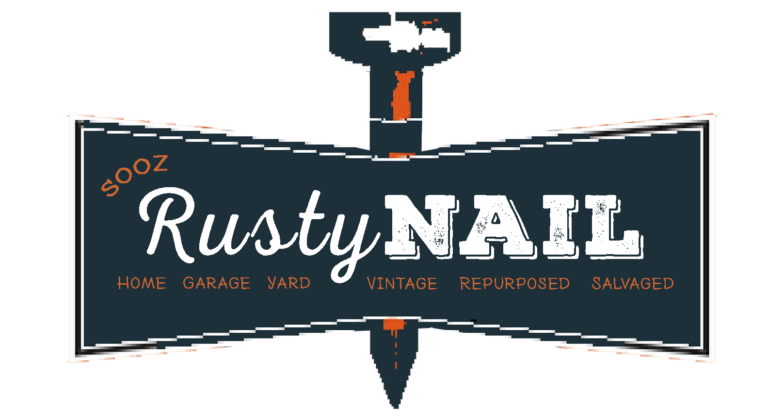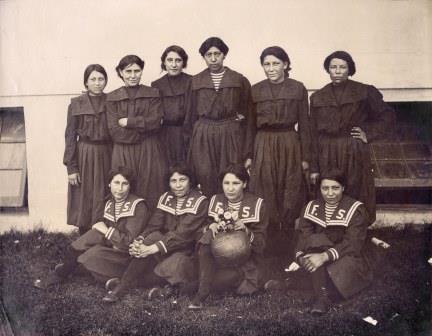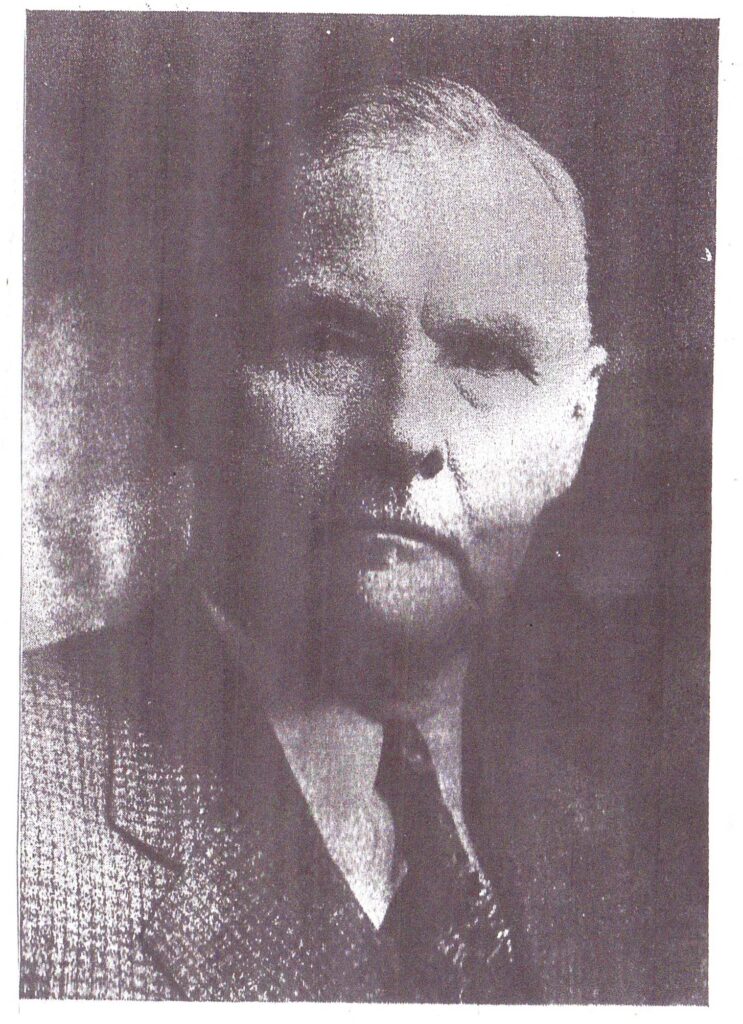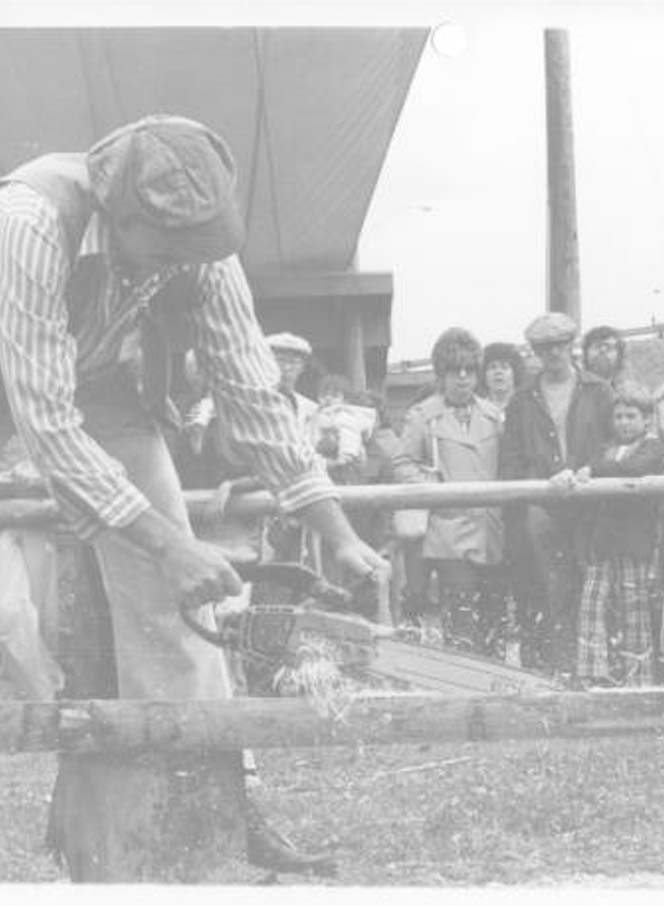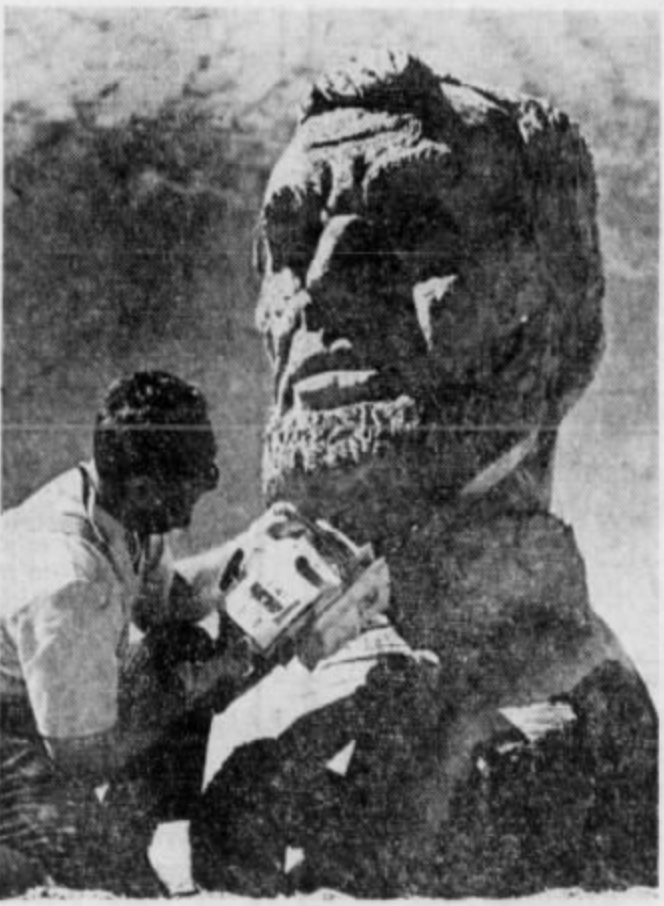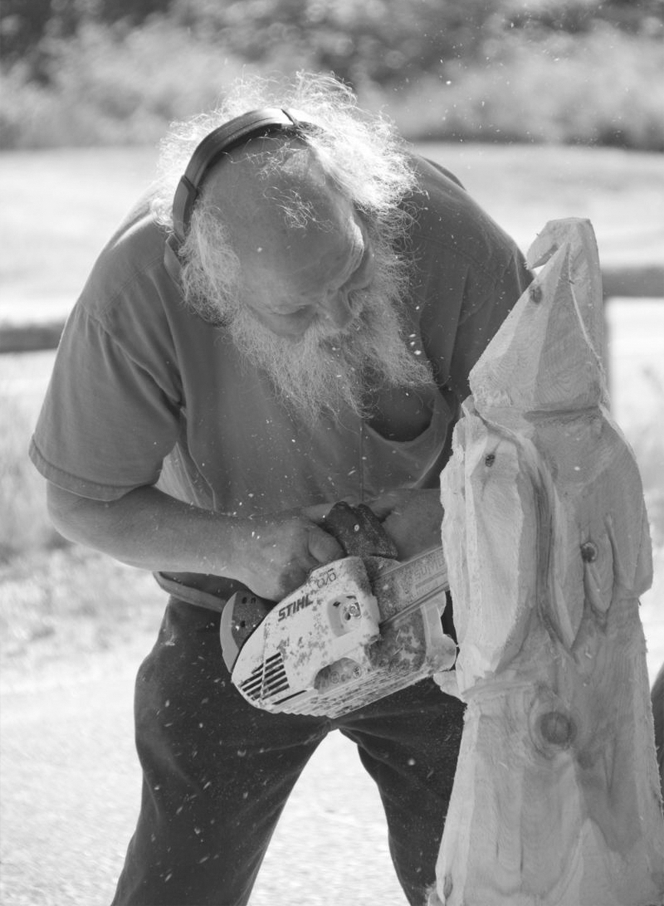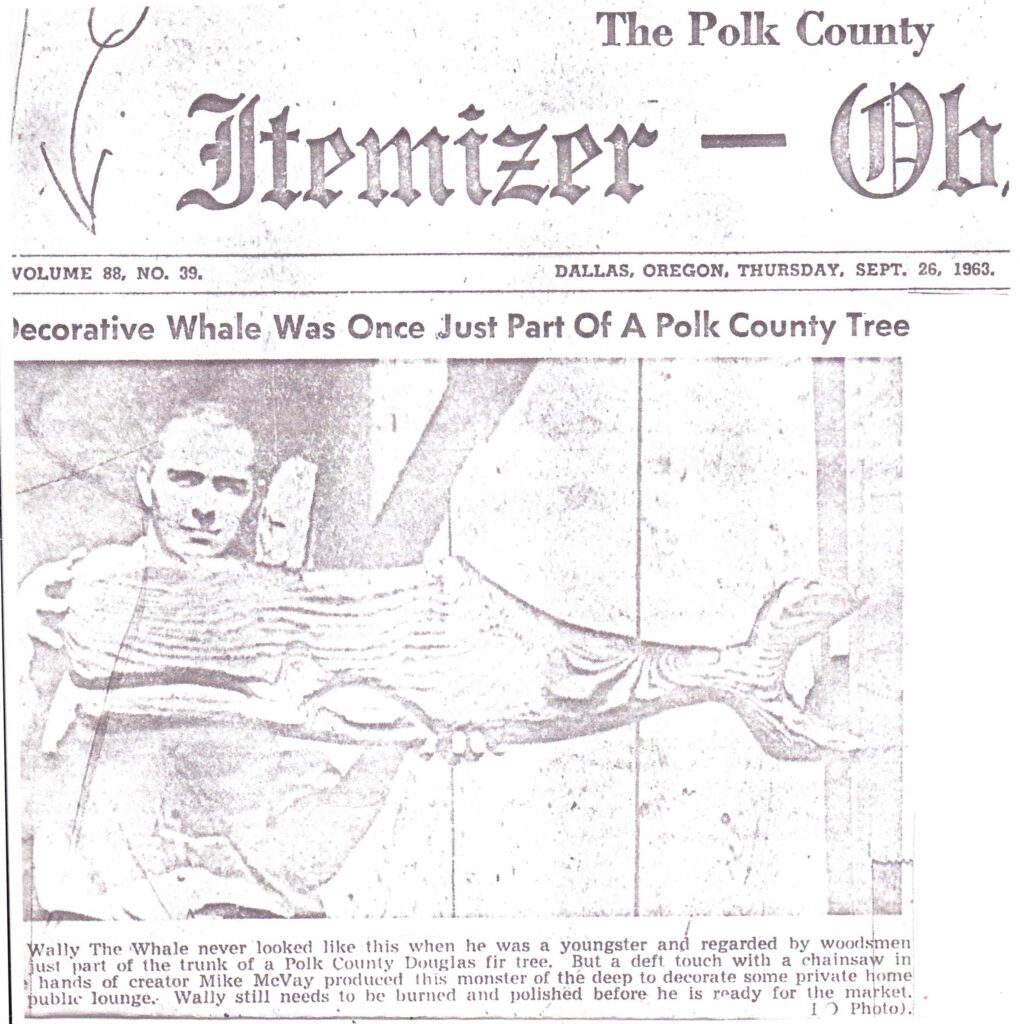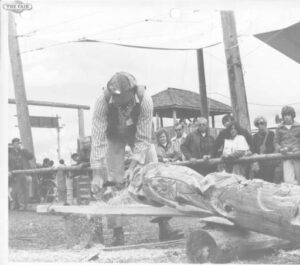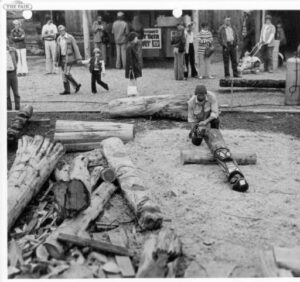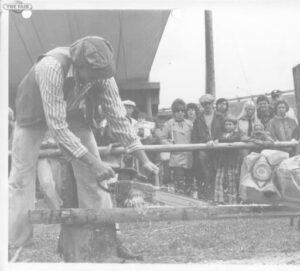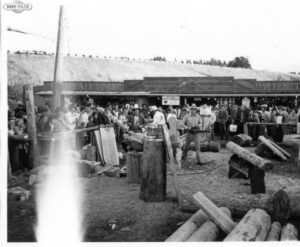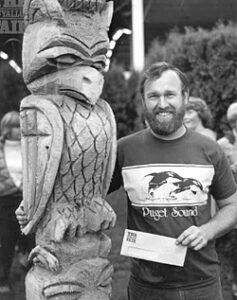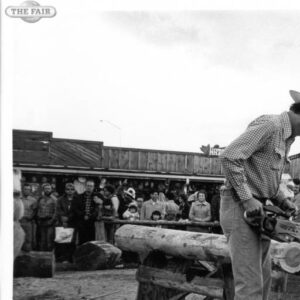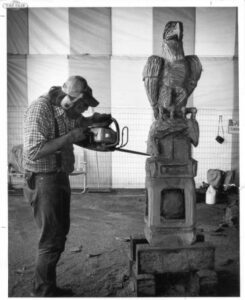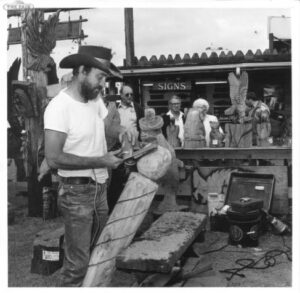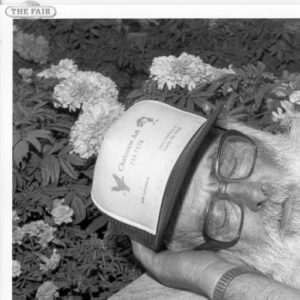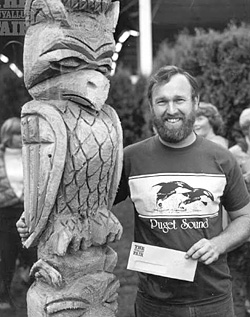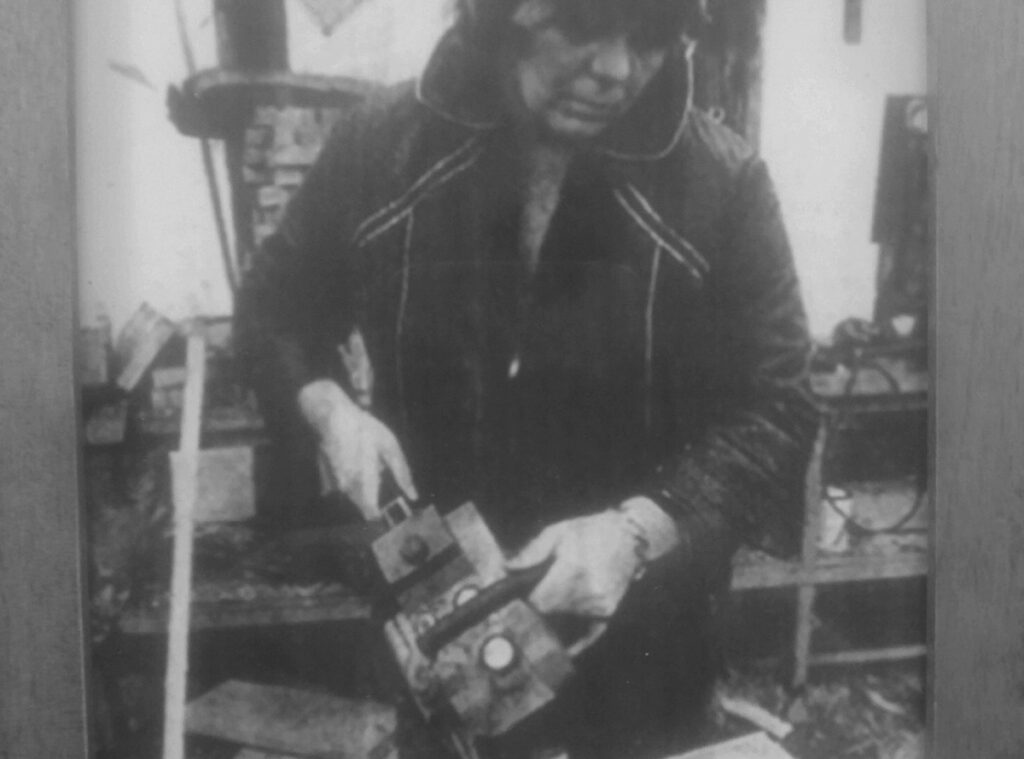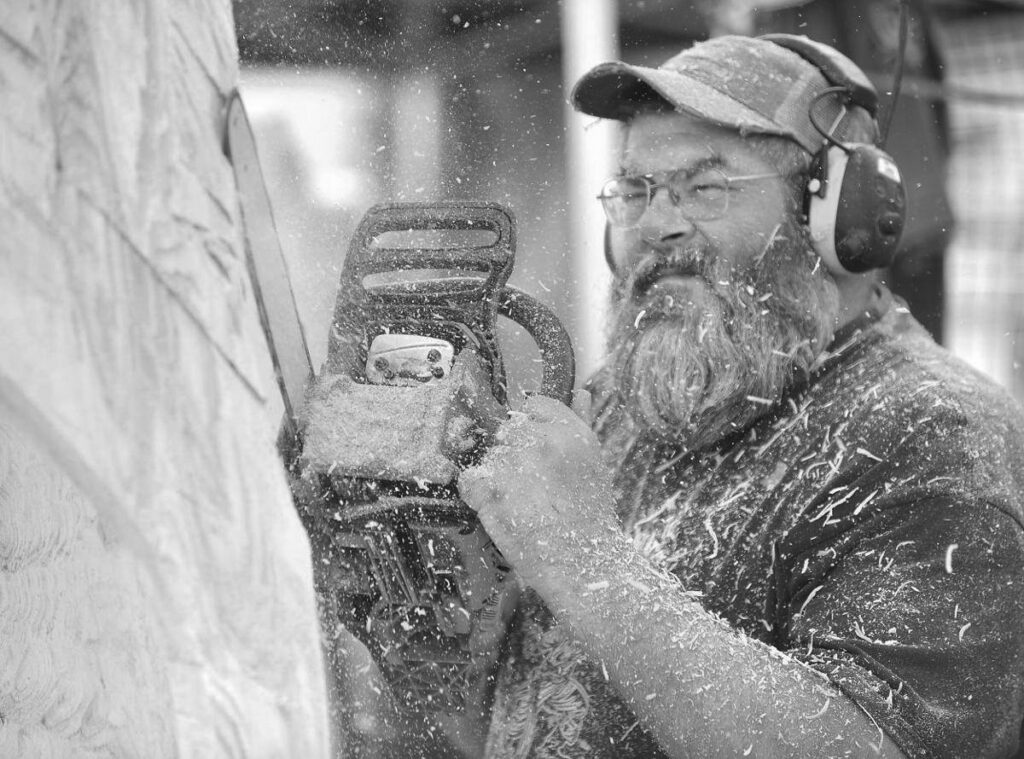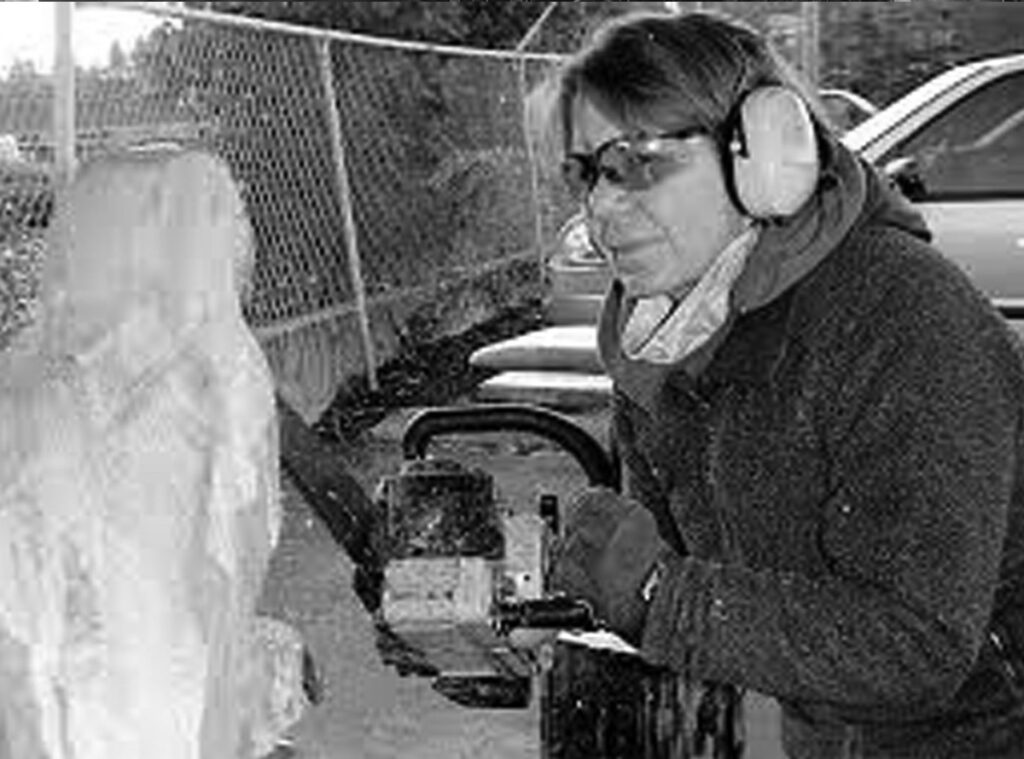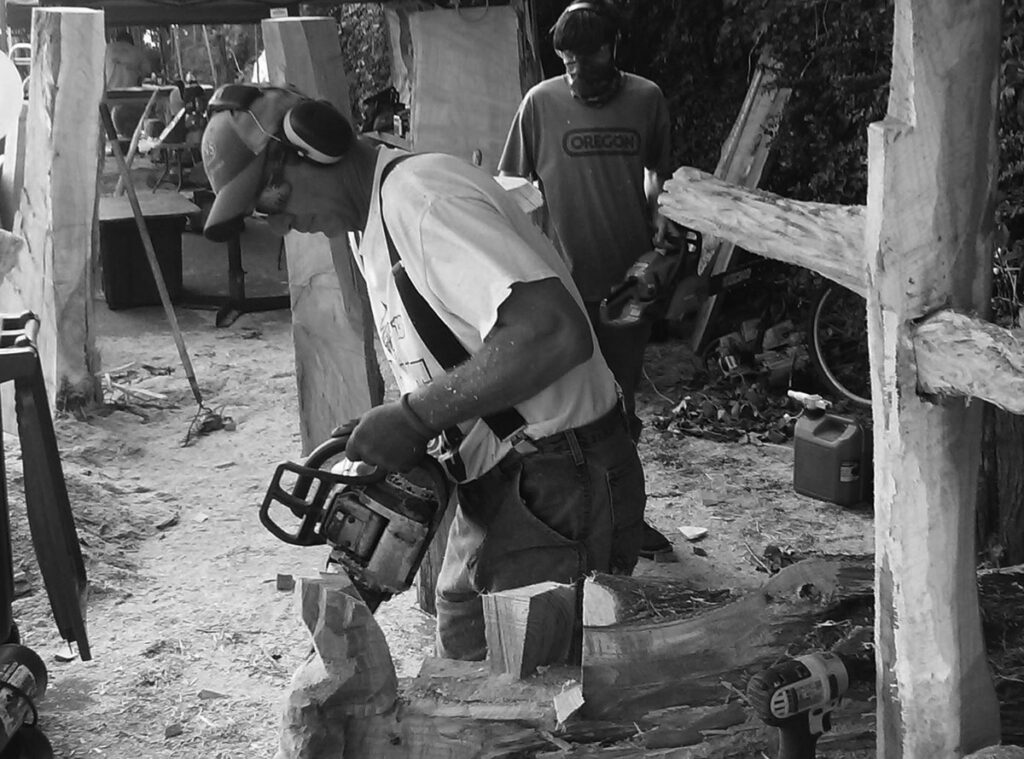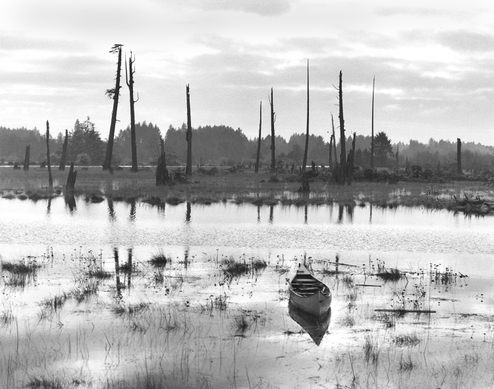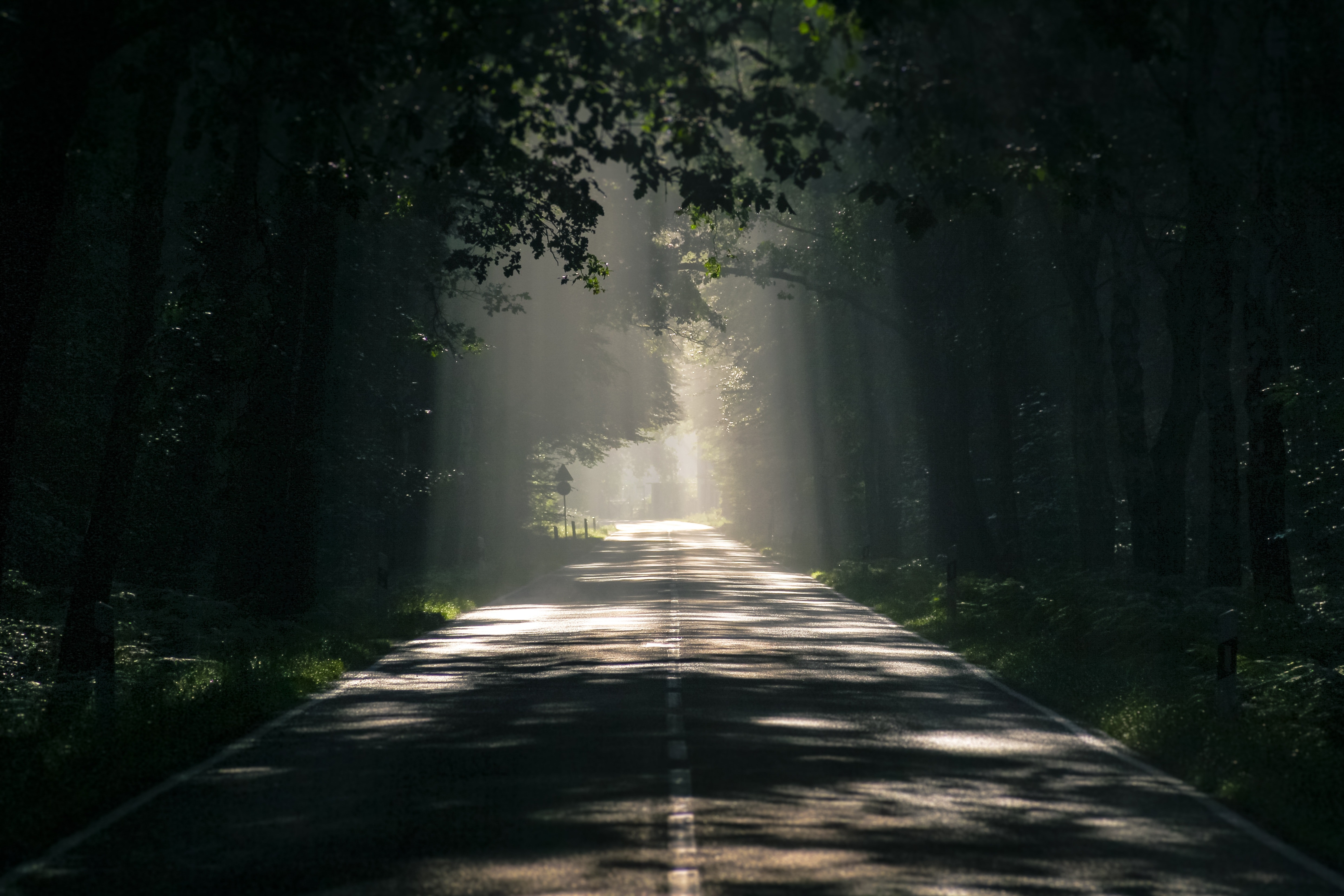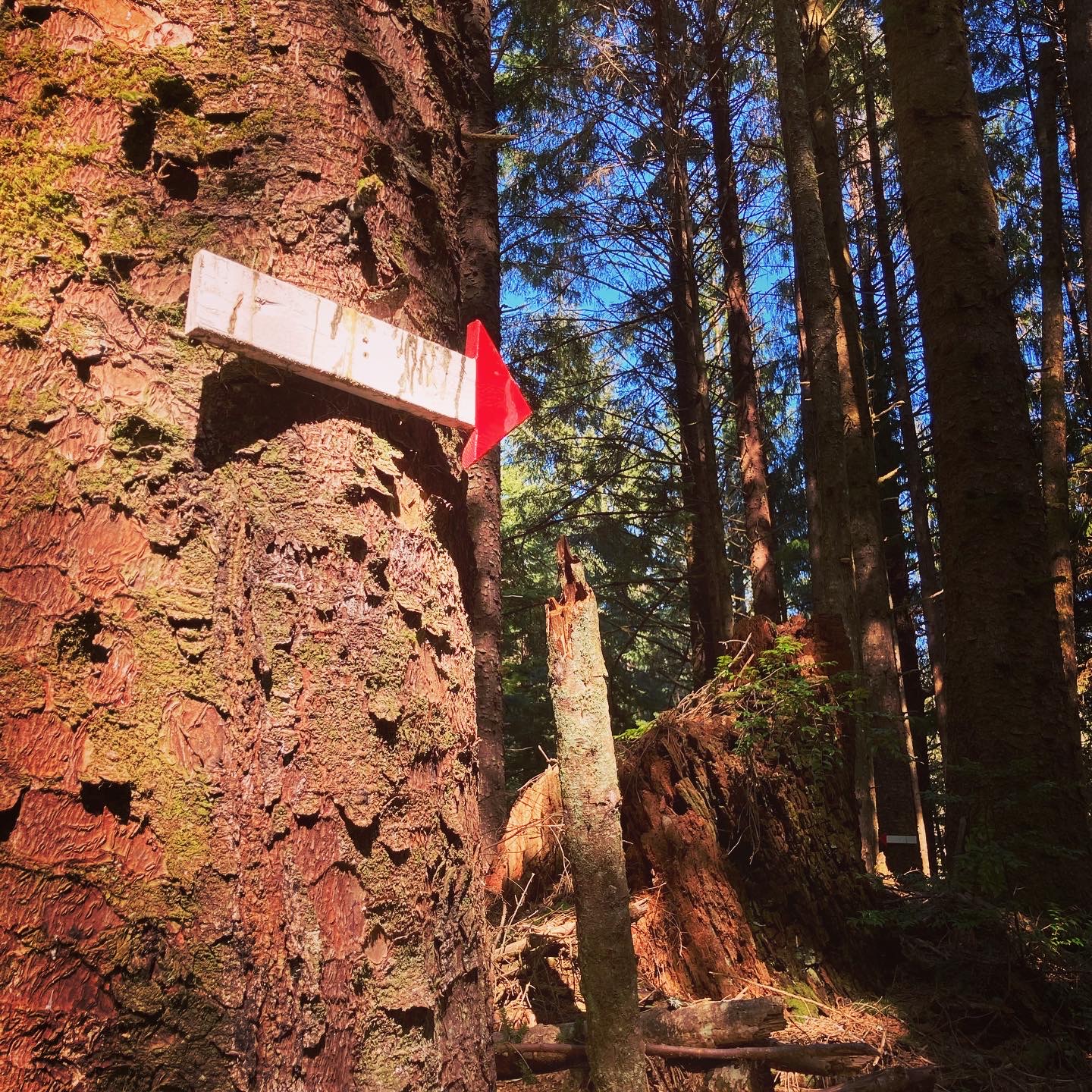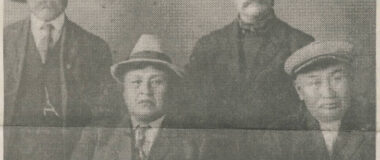“EVERYTHING IS THEORETICALLY IMPOSSIBLE, UNTIL IT HAS BEEN DONE.”
-Richard Heinlein
In 1904, with overwhelming support from fans, a team of native American girls from Montana did what most considered an impossible feat. They left the safety of their reservation school and endured harsh anti-Indian attitudes all the way to St. Louis, MO where they competed in, and won, the first ever World Basketball Championship. The events leading up to this historical achievement were categorically supported by their school Superintendent, FC Campbell, the namesake of Glacier National Park Campbell Mountain, who later served as a two-term United States Senator.
Born in Montana, FC Campbell’s grandson Dee McVay had a lifelong fascination with water, first learning to dive in area lakes and later retrieving logs from the bottom of Idaho rivers. In 1954, he seized an unusual logging opportunity. Over the next decade, McVay and his dive team recovered and milled 10 million board-feet of old growth timber submerged in Eel Lake near Lakeside, Oregon. A father of four, World War II Navy Seabees diver, logger, police officer, boxer, mill operator, and owner of an underwater salvage company in Saudi Arabia, Dee has been described as, “a man of action, unafraid of the future and with the courage to leap in unexplored directions.”
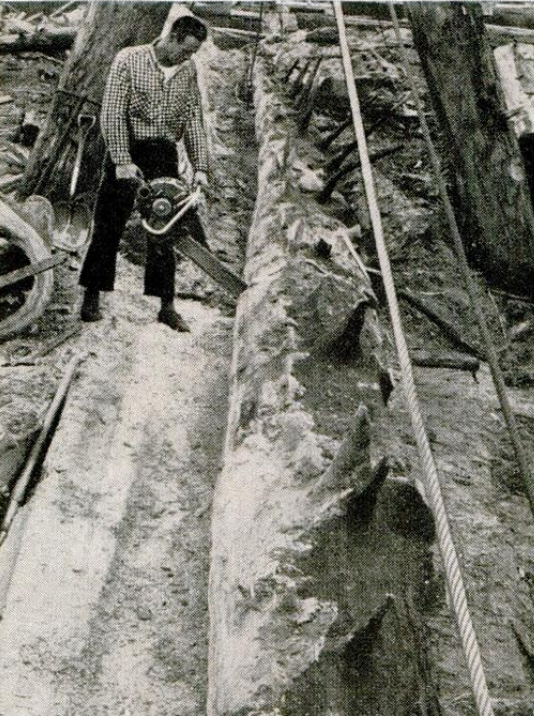
WHO'S ON FIRST?
Nobody knows for sure who carved the first piece of art with a chainsaw. We do know with certainty, that in 1948, Paul Bresee opened a chainsaw shop in Hoquiam and by 1956 he’d carved multiple pieces including a Paul Bunyan. Later, in 1960 his original Charlie Choker mascot statue was proudly displayed at Grays Harbor College.
Around that same time, Dee McVay’s son, Mike carved his first tiki from the butt end of a log salvaged at Eel Lake in 1956. And Ray Murphy, self-proclaimed “First Chainsaw Sawyer,” and famous quick-carve attraction reportedly sold his first sculpture in 1960. While Ken Kaiser, often credited as the “first,” was interested in sculpture art but didn’t actually use a chainsaw until he commissioned by the Trees of Mystery in 1962.
Mike, who had long been more interested in art than logging, spent his summers while attending college between 1956 – 1960 at his father’s Eel Lake Mill, chainsaw carving sculptures of small animals and selling them at local fairs and festivals. In 1961, Mike stuffed his dad’s VW truck with carvings and set off to exhibit at The Salem Art Fair and Festival. By 1963, at age 25, Mike McVay was a bona fide commercial carver, first hiring an employee and opening West Winds Original Designs, a retail carving shop, then carving a 30-foot Paul Bunyan for the Albany Timber Festival grounds. The carve of a lifetime quickly followed when he was commissioned to carve six large wood panels measuring 50-feet in length, depicting Oregon’s history for the 1964-65 New York World’s Fair. But it was his guest spot on To Tell The Truth, while in New York, that first brought chainsaw carving to mainstream television.
Unfortunately, prosperous times are often followed by tragedy. In Mike’s case, his shop burned to the ground in 1963, rendering him penniless. In response, and with support from his dad, Mike took a job abroad. But, before leaving, he taught Susan Miller and his sister Judy McVay the basics of chainsaw woodcarving, a skill they used as building blocks for expansive carving careers. By doing so, Mike unknowingly inducted them into history as the first women chainsaw woodcarvers in the world; Judy in Washington, and Susan in Oregon.
<1970 – 1975> CHAINSAW CARVING HASN'T BEEN THE SAME SINCE!
In 1970, Mike returned from his travels, landed with Judy and her kids in Humptulips, and was quickly followed by younger siblings Pat and Eileen McVay. Together the clan formed a family business with Mike and Judy as the chainsaw carvers. The origin of the term “Carve or Starve” comes from this early period when the McVay siblings became “the family that carves together, starves together,” a sorta-inside-joke that stuck.
With an abundance of wood available, Mike and Pat, along with friend Louie, spent the days foraging old logging haunts for downed and buried timber to reclaim. Some of it they split into shakes and sold, while others were turned into woodcarvings. In 1972, Mike and Judy co-carved their first collaborative piece; the Humptulips Cemetery sign. From there it was a whirlwind of early carvings, totems, and signs sold and bartered primarily to businesses in and around Grays Harbor County. They also created small totems and sculptures sold to the public at retail and gift shops along the North Washington Coast and Olympic National Forest areas.
In 1975, as a group, the McVay siblings decided to expand operations. That perfect location was found on Whidbey Island when a nursery came up for sale. Purchasing the property, they ran it as Whidbey Island Nursery and McVay Woodcarvings. Mike and Pat McVay had homes elsewhere on the island but worked at the shop; Judy and her school age kids, Steve, Lynn, and Boaz lived in a house on the shop property. The family began to mass produce furniture, sculptures, and signs sold retail at the nursery location and wholesale to furniture shops as far north as Alaska.
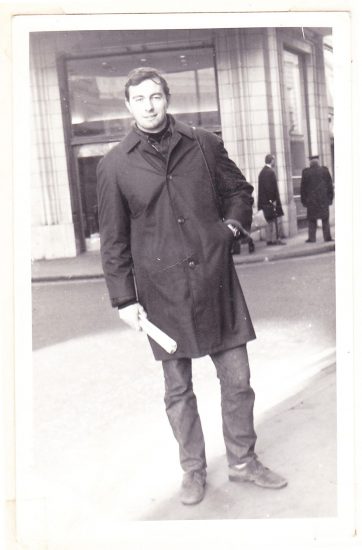
<1976 – 1980> DO THE PUYALLUP!
What started in 1900 as the Puyallup Valley Fair has grown considerably as it transitioned through several name changes; first as the Western Washington State Fair, then The Puyallup Fair, and finally The Washington State Fair. Now over 120 years old, for those of us who grew up here, thanks in large part to a commercial that aired in 1976 with a catchy little tune, it will forever be “The Puyallup.”
Mike McVay began carving at the Fair as entertainment in 1976, the same year as the catchy commercial. It was during that time that he met Bob Carlson, CEO of the Puyallup Fair (1972 – 2004) at a Seattle home show where the McVay’s art was exhibited. The Fair booth was technically Mike’s but the whole family showed up to help, rolling in with a camper and setting up on a 30-foot grassy area where crowds gathered to watch Mike live-carve.
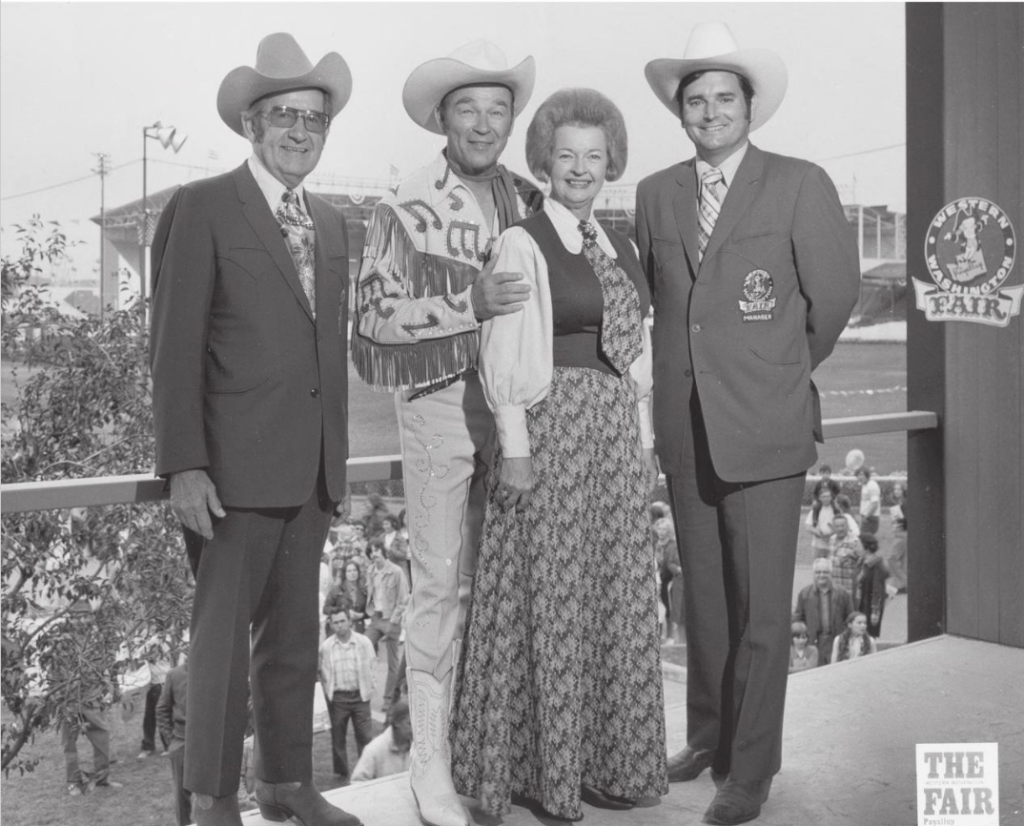
Click Images to enlarge. Photos courtesy of the Western Washington State Fair – Achieved at Tacoma Public Library
By the late 70s, the McVay woodcarving business had gained traction, going from just the siblings (and kids) to 11 employees all working at the shop on Whidbey Island. It was then that ECHO, an up-and-coming chainsaw manufacturer from Illinois, jumped at the opportunity to sponsor the McVays at events. Venues included the Puyallup Fair where in 1978, ECHO paid for the booth in exchange for promotion, and at home shows in and around Seattle as well as carving demonstrations at elite locations such as California’s Hotel del Coronado. As part of the agreement, the McVays also carved elaborate exhibit displays promoting ECHO and custom carved retail chainsaw display racks sent to ECHO dealer locations.
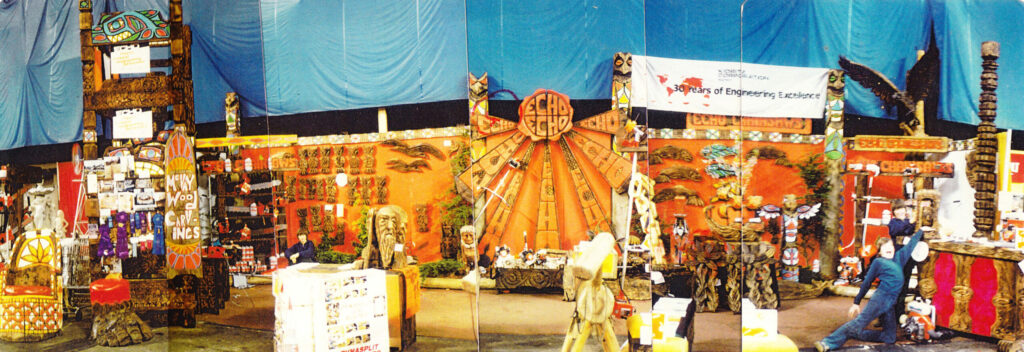
On August 11, 1978 the Whidbey Island Nursery and McVay Woodcarvings caught fire and, with all those gas-filled chainsaws and wood lying around, you can imagine it wasn’t a small fire. In fact, it destroyed the shop entirely, melted saws, vaporized inventory, and devastated their operations. But most tragically, they lost Jerry who was a dedicated employee and like a part of the family, who died in a car accident while rushing to help at the scene. After the fire, Mike retained his booth at the Fair and the family joined him there to carve each fall. And by 1981, the McVays and Fair officials had hatched a plan to host a carving competition as part of the showmanship angle they used to attract more visitors.
After the fire, the family remained dedicated to carving and shared the shop space after it was rebuilt but went their separate ways in business, conducting independent carving operations. Judy and son Steve who was a carver himself by then, in “carve or starve-style,” returned to selling carvings primarily on commission and at roadside venues.
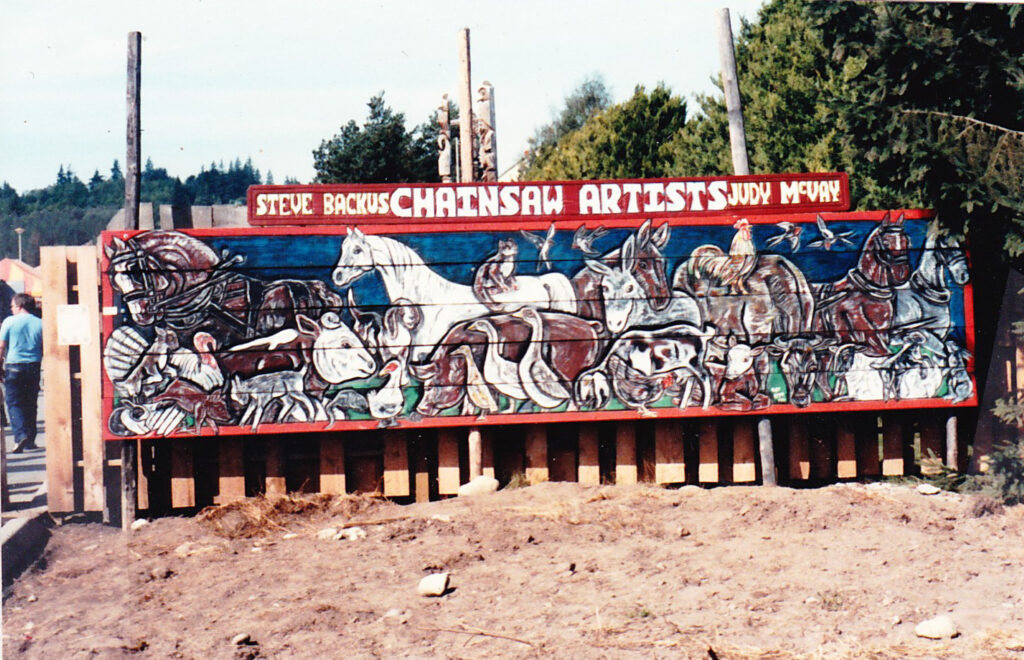
1981 USHERS IN THE FIRST-EVER WORLD CHAINSAW CARVING CONTEST
Seventeen carvers showed up to compete at the Puyallup Fair in 1981, including two women; Susan Miller and Judy McVay. The 15 male competitors included fifth place winner, Lance Graham, third place Ralph White, second place Mike McVay, and first place Bob Canterbury from Quilcene, WA who was introduced to carving when he met Mike in 1977 at the Fair.
This first ever chainsaw woodcarving competition ran very differently from competitions today, with the Fair in charge and little to no input from carvers. For instance, the carvers weren’t exactly paid and there were no live auctions or quick carves. As Pat McVay recalls about 1981, “It was quite an event, we each had a 23-foot cedar log that you had to carve into an 18-foot totem pole, leaving the rest so they could put it in the ground; and we had to do it in six hours.” Judges chose the top five totem poles, which the Fair kept for display, and the remainder were sold to the crowd in a silent auction with a minimum bid of $150. Proceeds were then split among all the carvers so, in short, there wasn’t much in it beyond bragging rights.
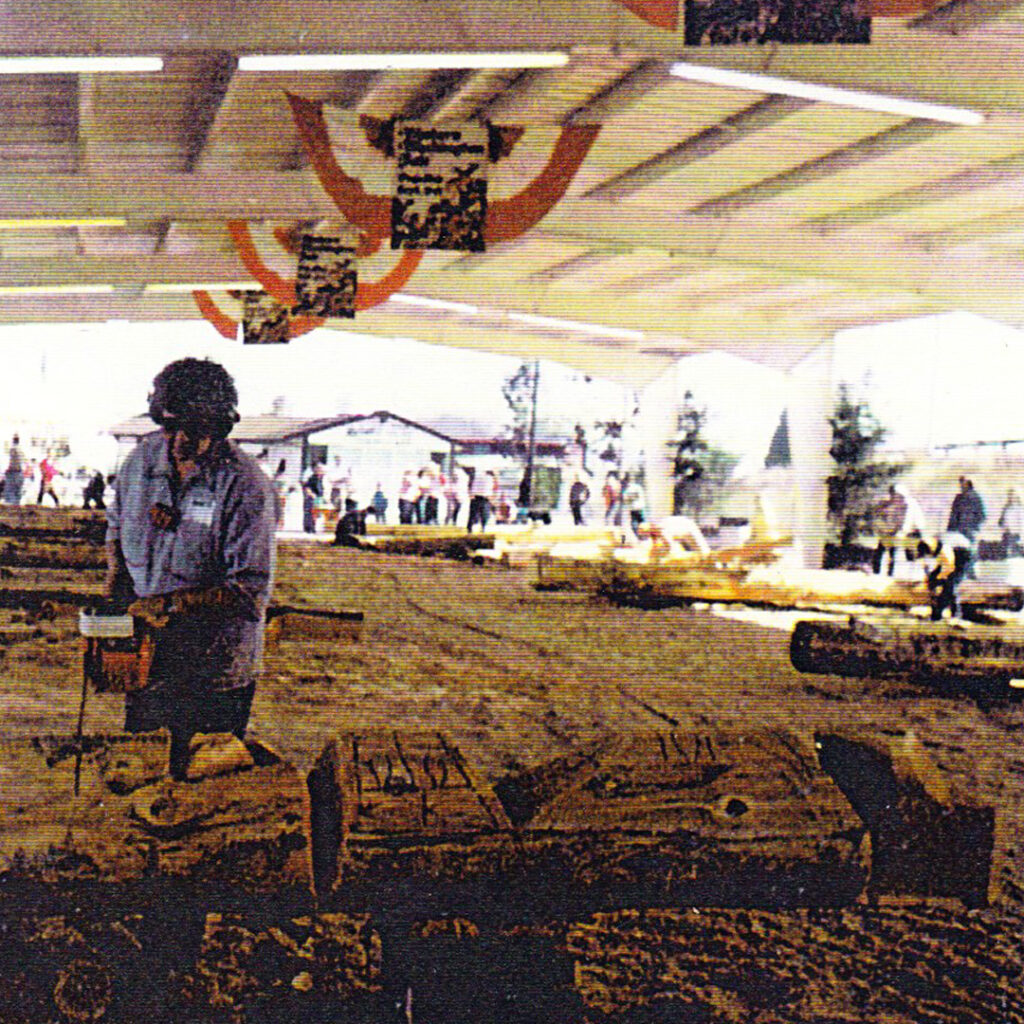
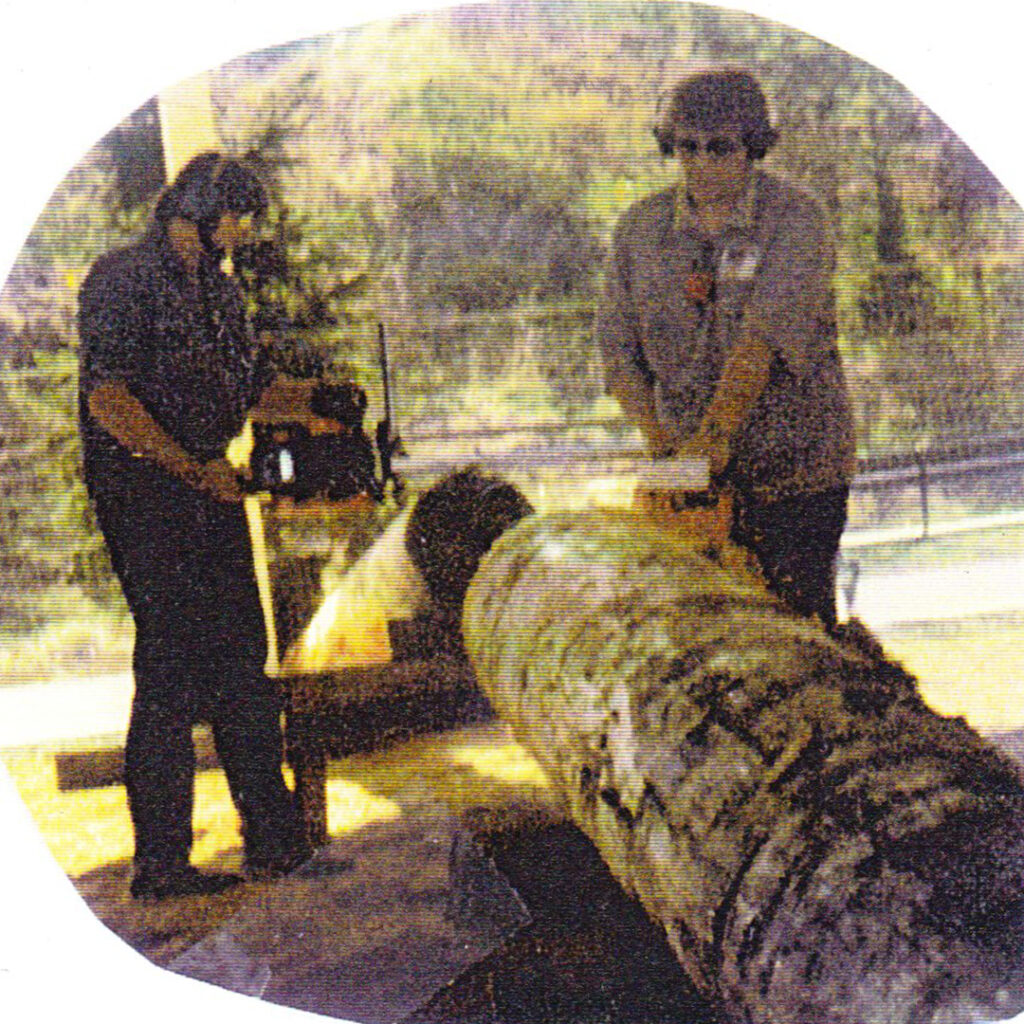
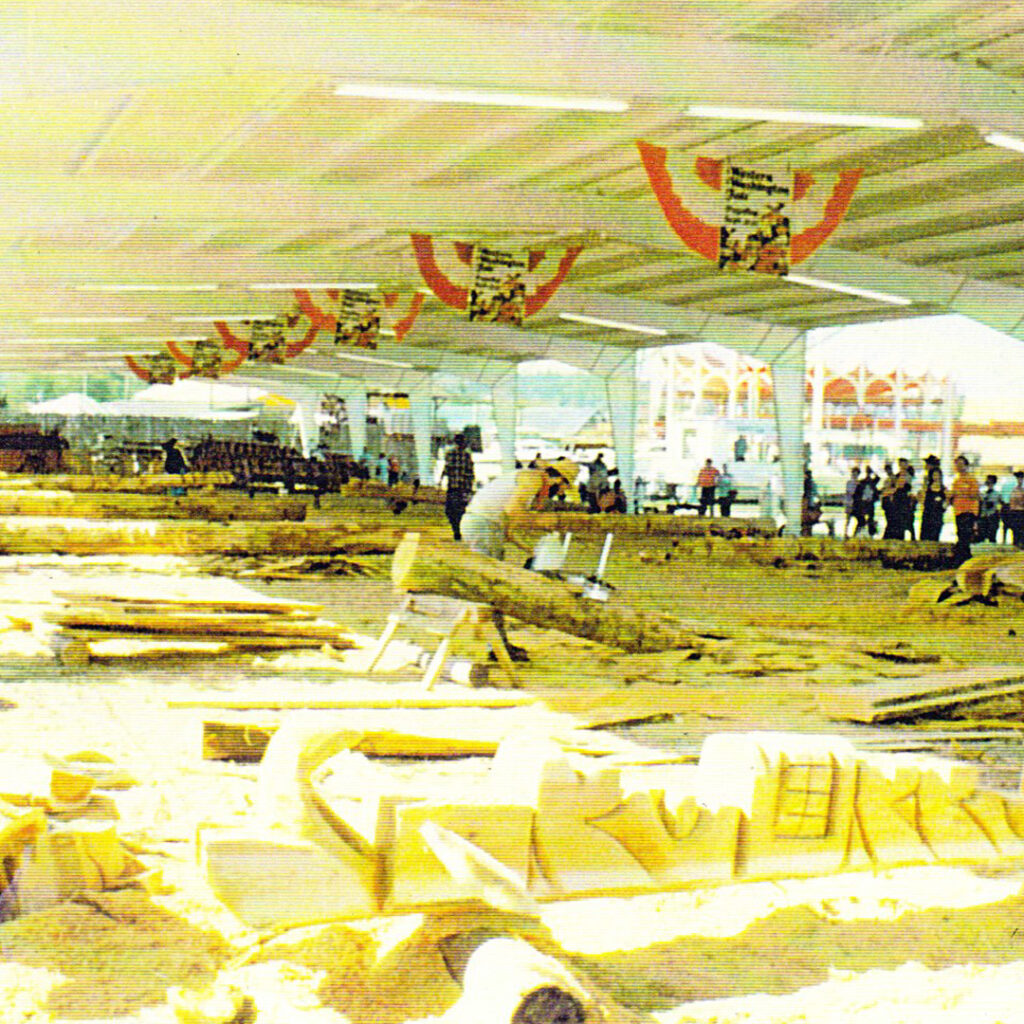
--> TOTEM CARVING — A HIGHLIGHT OF THE FAIR <--
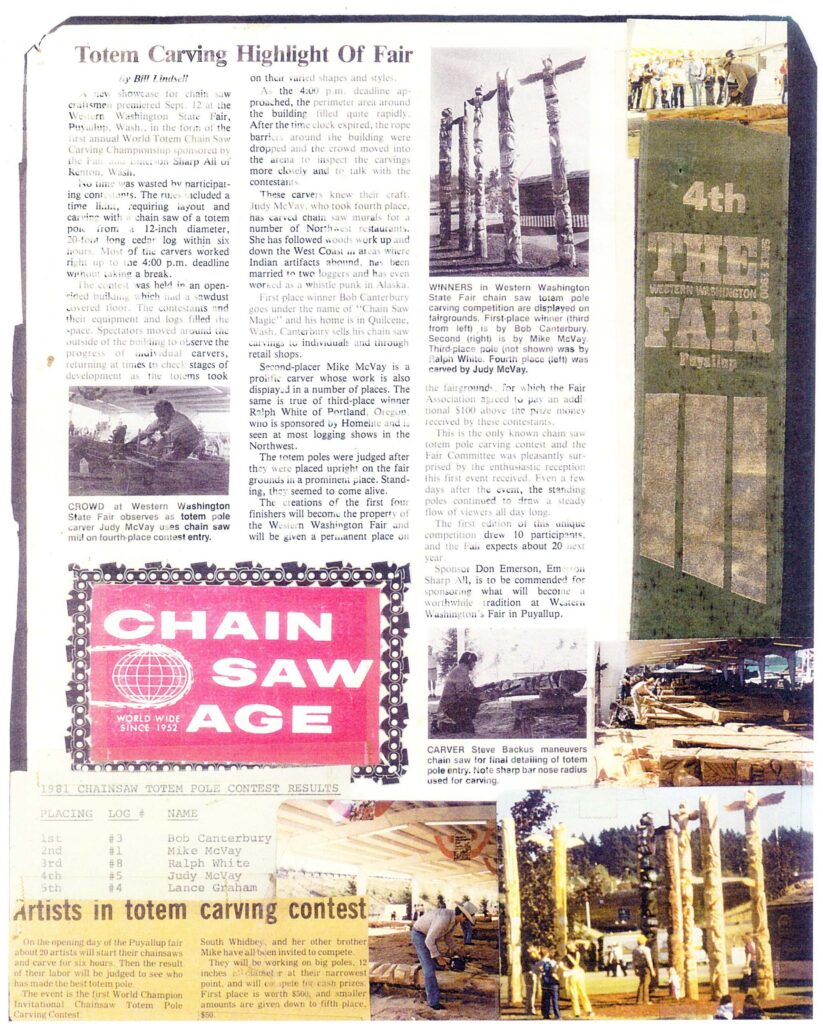
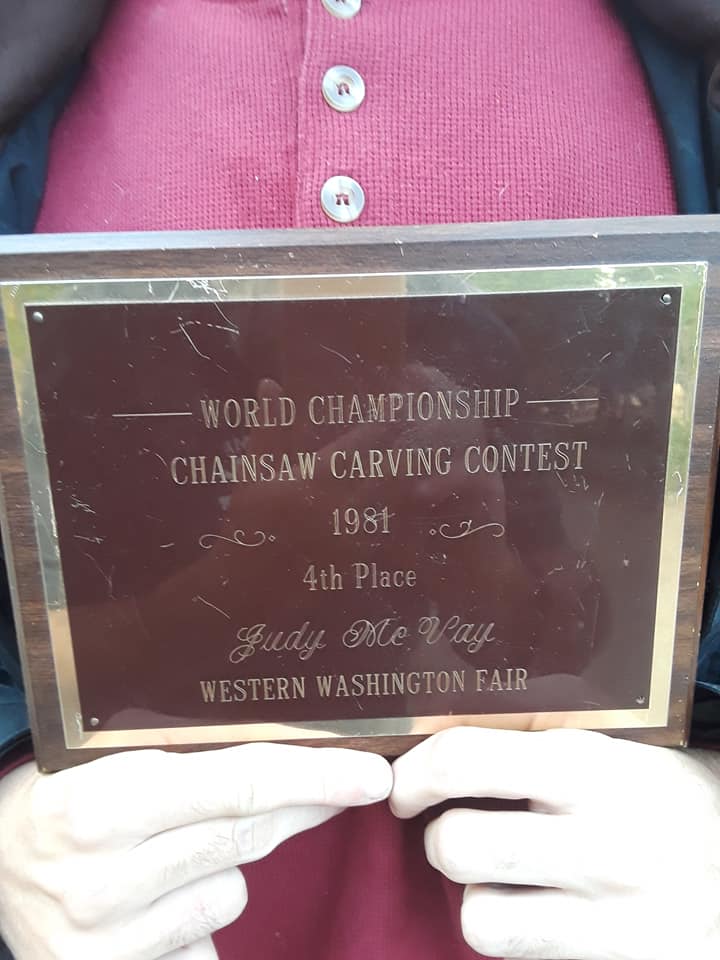
In that first competition, Judy McVay placed fourth, making history as the first woman to compete in and place at a chainsaw carving competition. The following year (1982) at the second competition, Bob again placed first and Judy placed fifth. In 1983, the Fair repeated the same competition style but in 1984, they stopped doing totem poles and let contestants carve their competition pieces from six-foot logs.
The top five totems from 1981 – 1983 (15 totems total) stood sentinel at the fairgrounds until each one deteriorated and was moved to the back 40, eventually meeting its demise in the burn pile. Tragic? Yes! But there is a somewhat happy ending. Bret Bosley began working maintenance at the Fair in 1982 and watched as each pole was eventually marked for destruction. By 1999, Judy’s 1982 totem pole was the sole surviving, standing totem but sadly, it too was headed to the burn pile.
Call it foresight, call it divine intervention, call it a love for history – but whatever it was – Bret convinced his boss to sell him the pole for $20 and he took it home and saved it from certain death. In 2020, Bret graciously released the pole back to the public domain where it will soon be put on display again, this time as a salute to Judy McVay’s place in chainsaw carving history.
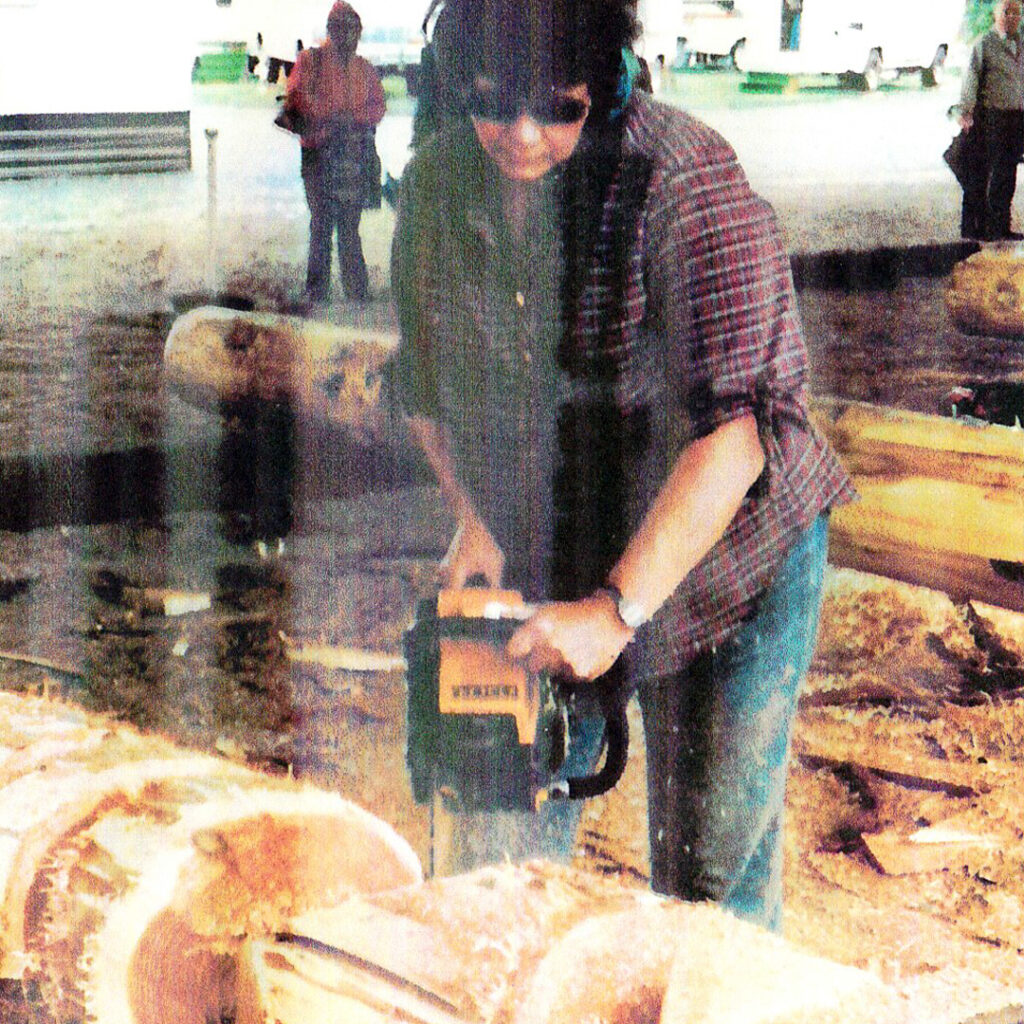
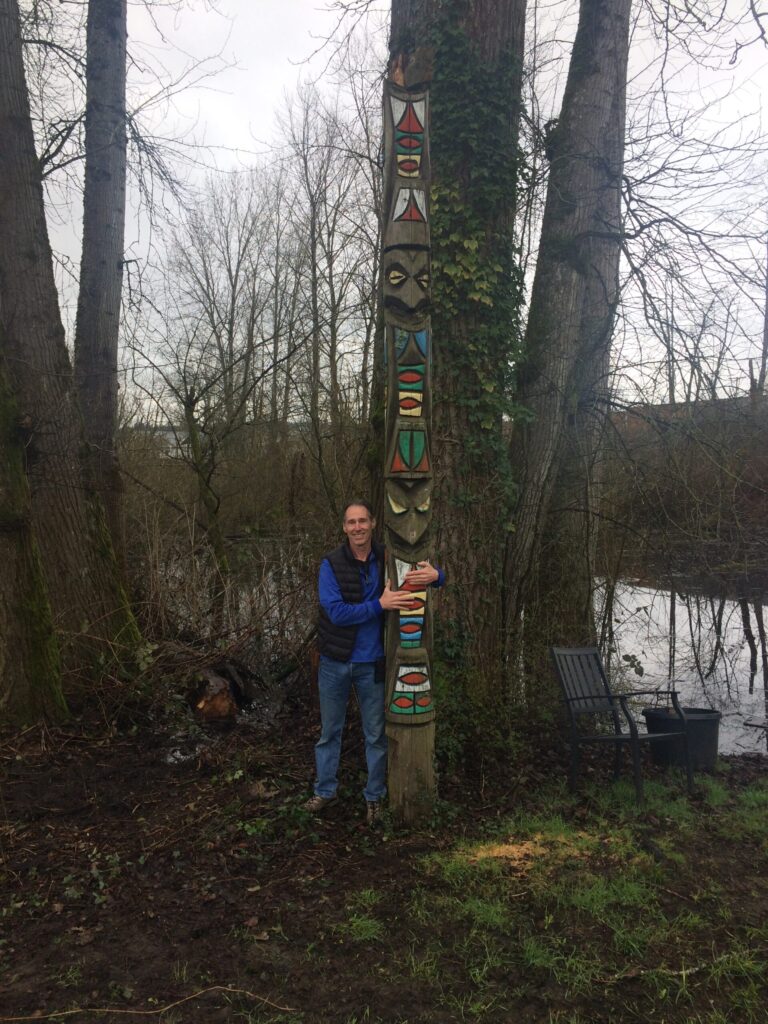
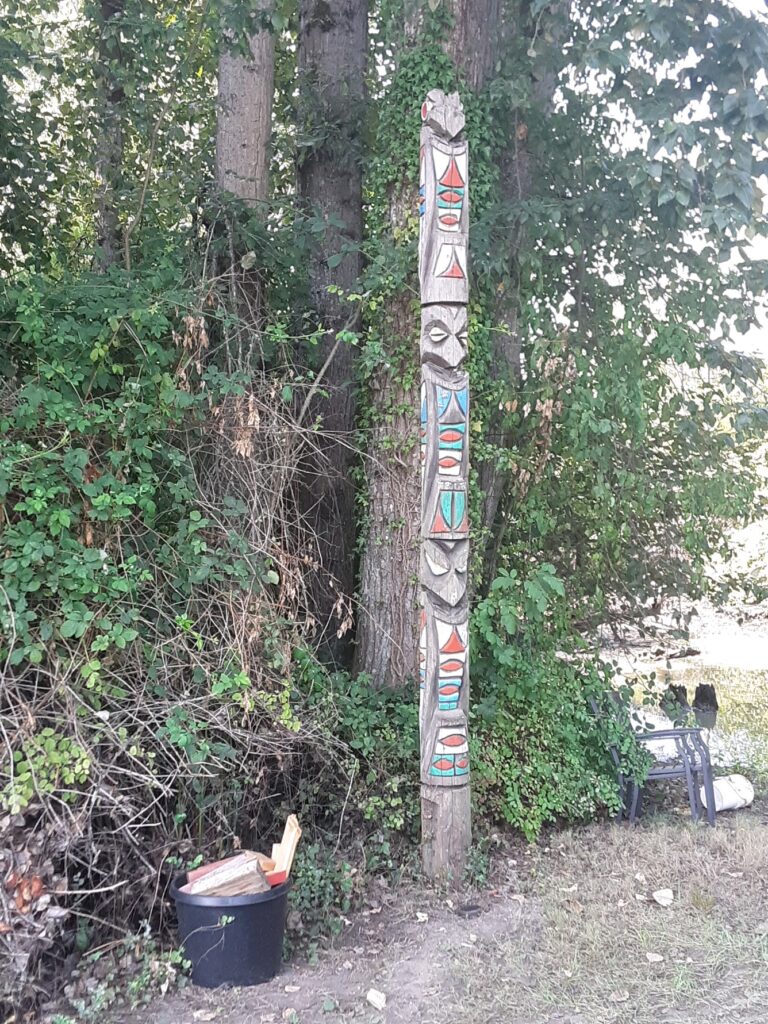
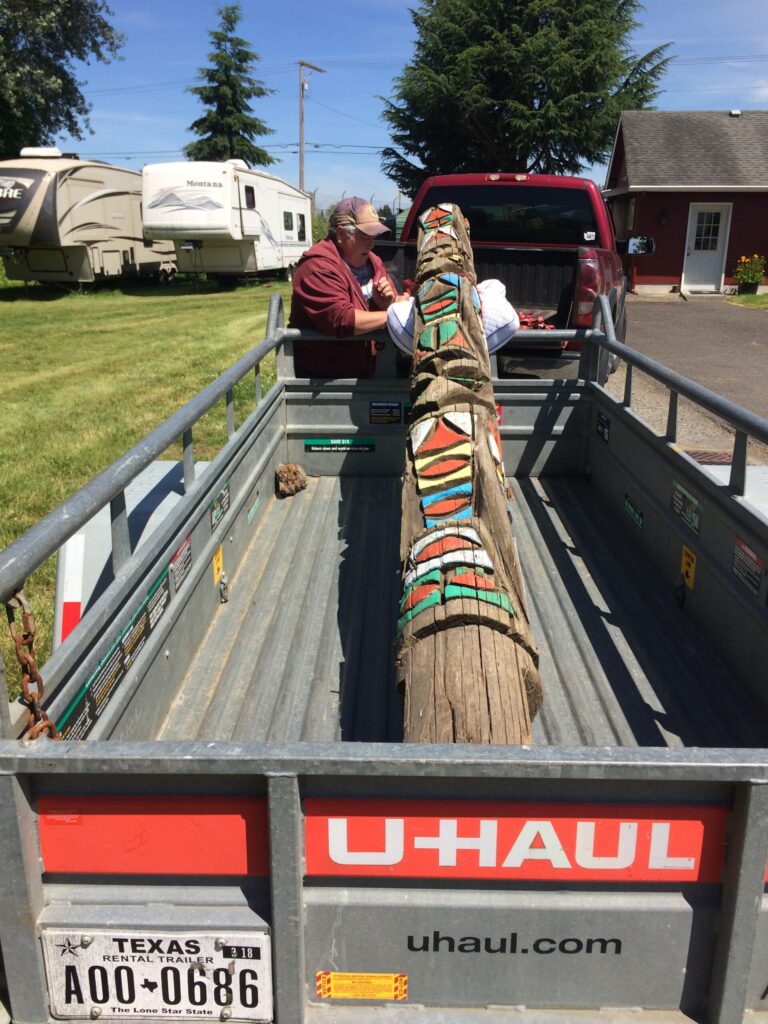
Although chainsaw carving remains an attraction at the Puyallup Fair, the last competition held there was in 1988.
<1981 – 1983> M0RE COMPETITIONS, PLEASE!
After the first couple of years of competitions at the Puyallup Fair, other contests began cropping up in Western Washington. Most notably, the 1982 Monroe Fair competition started by Walt Crane. A former judge at the Puyallup Fair, Crane ran the Monroe Fair in a similar fashion except that the Fair only kept the top three poles instead of the top five. Bob Canterbury placed first at Monroe in ‘82 winning both Puyallup and Monroe that year. In doing so, he will forever be remembered as the first contestant to win a chainsaw carving competition (1981), the first to win Monroe (1982), AND the first to win at both fairs, back-to-back in the same year (1982).
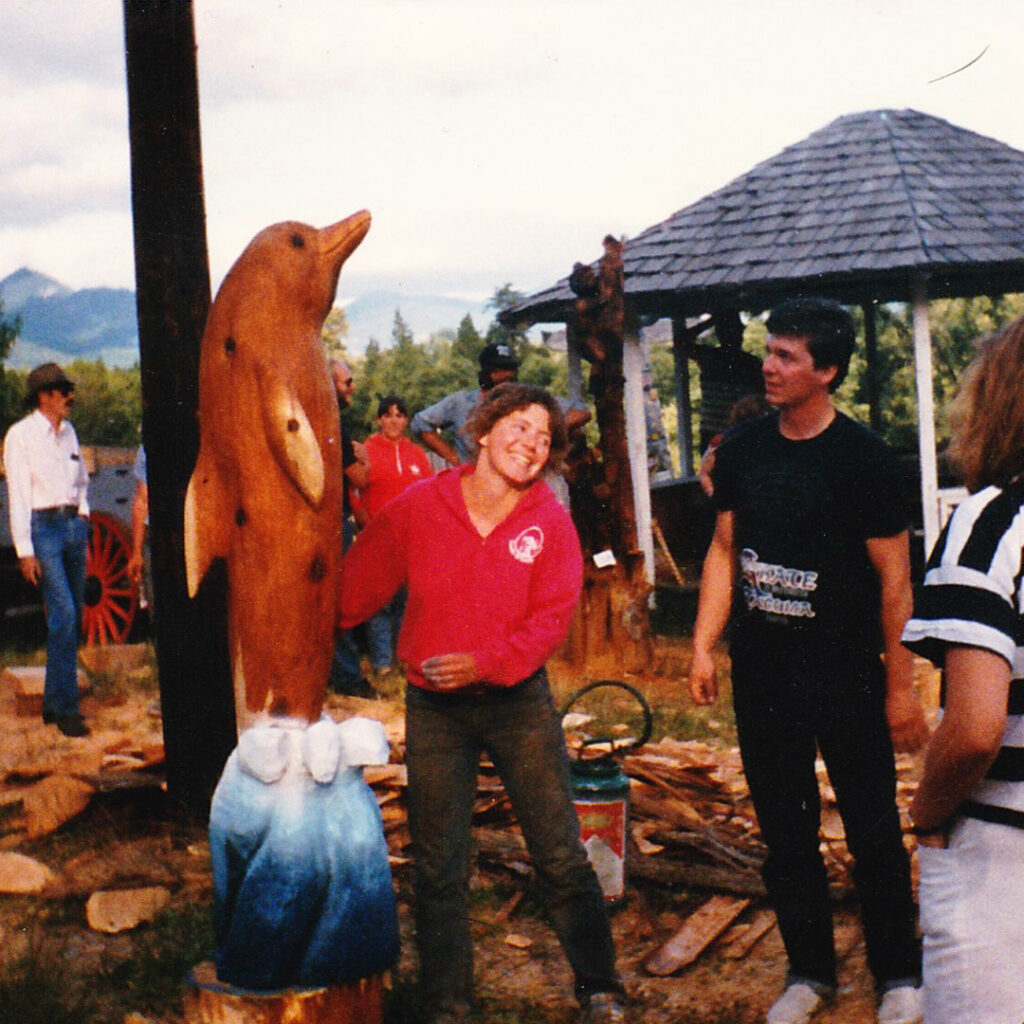
Another early competition started in 1983 but was different – in a good way. Duke Moore, another Puyallup Fair judge and a hand carver, held the event at his property in Ashford near Mt. Rainier. Duke knew how much time, effort, and skill went into carving and because of this, his competitions were naturally more pro-carver. For example, this was the first time carvers were allowed to keep their unsold pieces; a small act of understanding that shaped future events.
1987 WELCOMES THE CASCADE CHAINSAW SCULPTOR'S GUILD
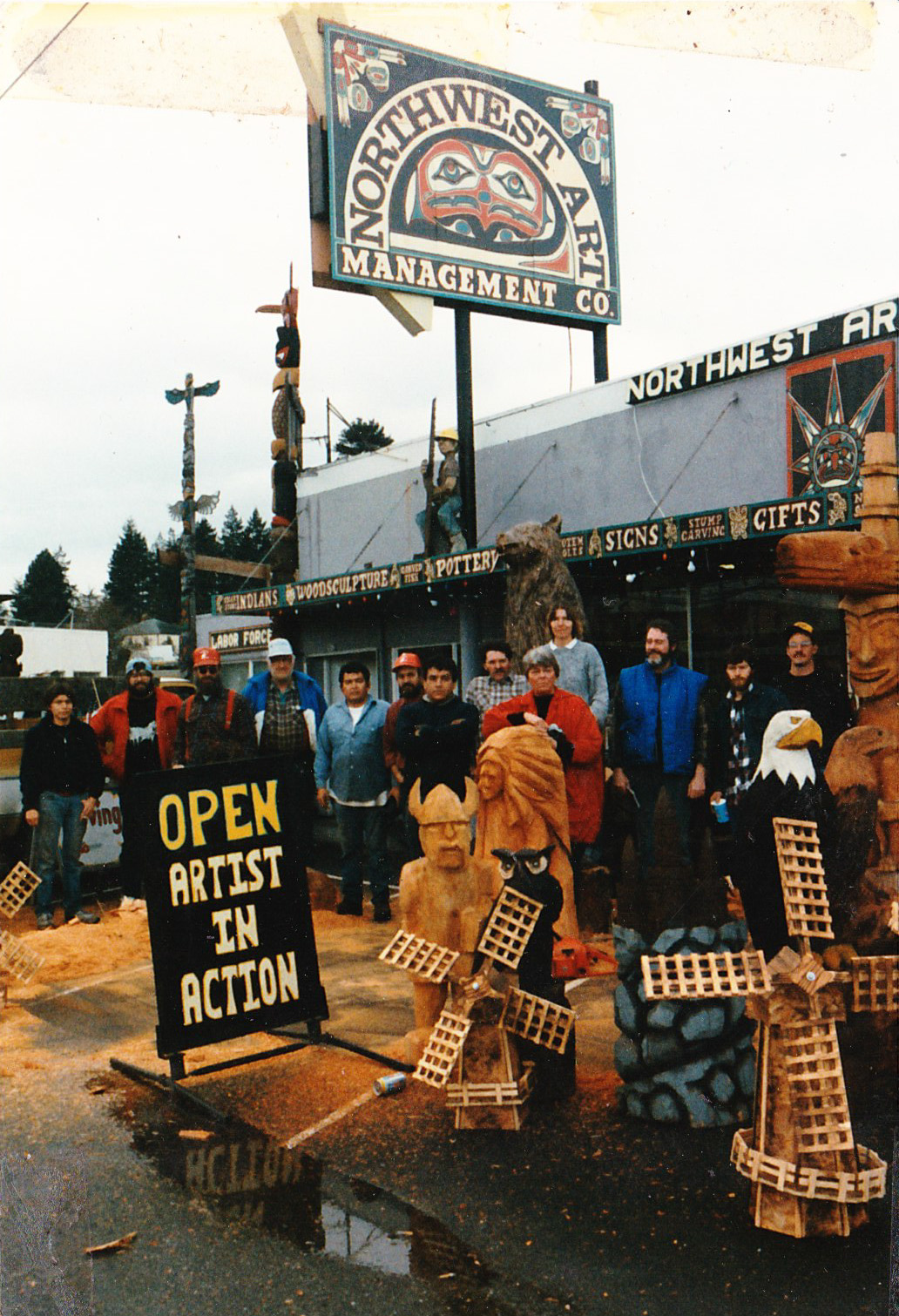
The idea that a governing body was needed began evolving early on as the handful of carvers in the competition circuit realized how much better it could be for them if carvers developed the rules rather than venues taking that role. In 1987 several carvers including Judy and Pat McVay, Steve Backus, Susan Miller, Bob Cox, Joaquin Quezada, Larry Carter, and the first Guild President, Oly Shear came together and officially registered the Cascade Chainsaw Sculptor’s Guild as a nonprofit organization. But the Guild wasn’t only about competition, it also served as a much-needed communication channel for carvers who knew they would benefit from staying connected and sharing knowledge – and remember – the internet wasn’t there for them back then. Starting in 1993, Pat McVay and Jessie Groschen painstakingly crafted a monthly newsletter that was typed and cut-and-pasted together before photocopying and mailed to members. The content covered news, tips, event notifications and highlights, advertisements for chainsaw art related products and services (such as carving bars and classes), stories told by Steve from his cross-country travels with Pat, and stories from other members who sent in letters.
BRACING FOR THE 90s — LIKE MOTHS TO THE FLAME!
By 1990, carvers predominatly located in the Pacific Northwest, were meeting regularly at several annual events including the three originals; Puyallup, Monroe, and Duke’s. Mike was still by far the most famous carver at the time despite the fact that he’d opted out of competitions in 1982 in lieu of spending summers roadside carving in Alaska.
In Mike’s wake, Steve Backus and Pat McVay were ready to rumble! In 1986, the duo attended their first out-of-state competition in Hill City, MN. There, Steve competed against show promoter Barre Penske and carving pioneer Ray Murphy in the first ever “quick carve” competition, an idea Steve and Pat pocketed for later.
By then the circle of carvers had grown and although everyone knew that carving was gaining momentum, it was in Hill City where West really began meeting East. As Steve puts it, it was interesting to attend a carving competition where nobody had really heard about Mike McVay. It opened a whole new world as carvers from across the country quickly became friends – for life!
<1990 – 2005> THE BIG ONE INTERNATIONAL CHAINSAW CARVING COMPETITION, WESTPORT, WA
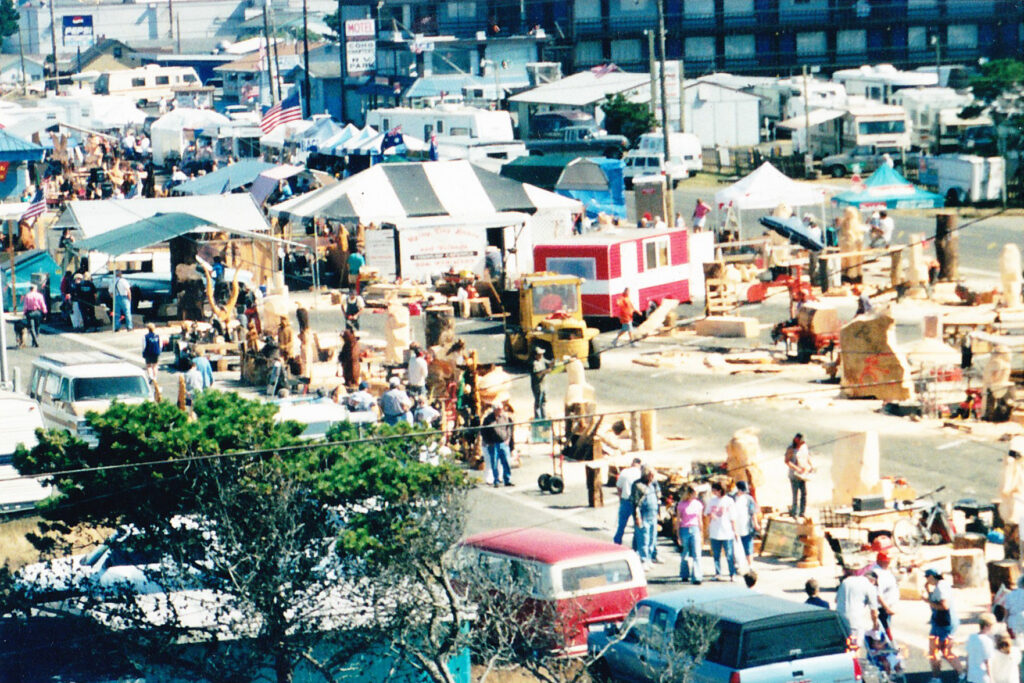
In 1990, on a fluke, the first Guild-backed event occurred.
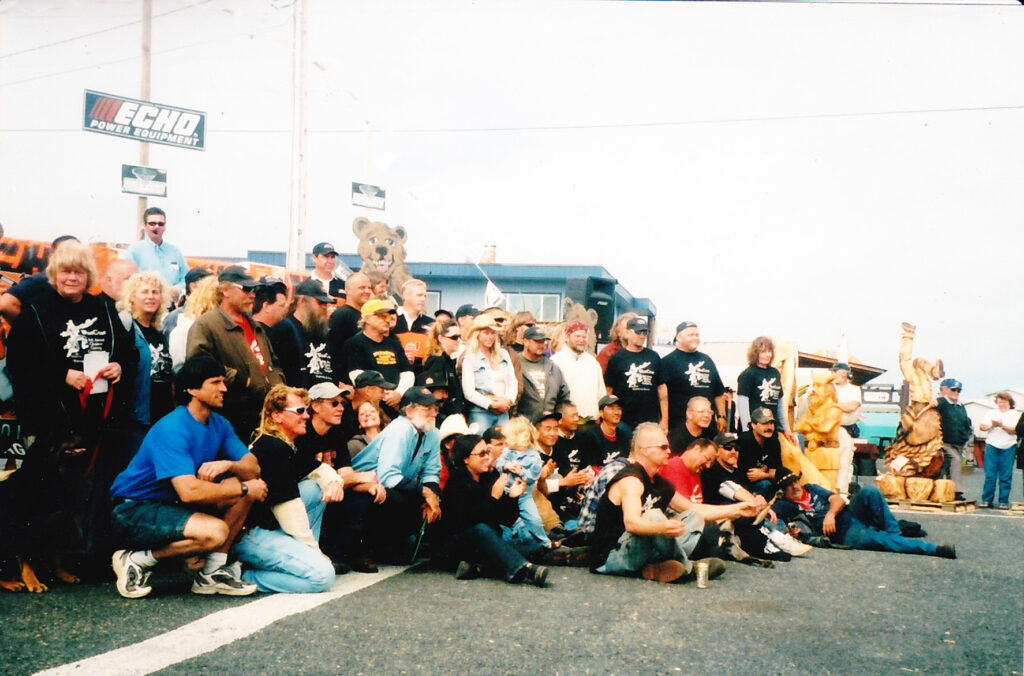
Welcome to Westport, Wa!
It was summer and Steve with his wife Nanette and their kids decided to take the long way home from Duke’s event and ended up in Westport, WA, a small town on the Ocean’s edge. There Steve met local motel owner Jim McBroom who was drawn in by Steve’s stories of carving competitions and wanted him to bring one to Westport. By this time, Steve had over 80 competitions under his belt, family ties to obtaining lumber, and an ability to wrangle volunteers. Just 60 days later, with backing from the Guild, the first annual Big One International Chainsaw Carving Competition was held at Westport.
The Big One started out grassroots and Steve oversaw operations. For the first three years there were “People’s Choice” contests judged by the audience, but short of selling carvings to attendees, there were few ways for carvers to make money. That first year (1990) 10 or so carvers showed up to create art along a nautical theme and Steve placed first (judged by the audience). Year two, 17 carvers showed, and Lynn became the first woman to ever place at Westport when the audience chose her piece. The event grew rapidly from there with 24 carvers in 1993 to 40 in 1995, and no less than 50 carvers each year for the next decade. In ’93 Steve and Boaz tried a quick carve + auction combination that was a huge hit and stuck as a staple for competitions from then forward. In addition, they began doing daily auctions with Boaz as auctioneer, which played heavily into the history of chainsaw carving events. The stage was leveraged as a teaching opportunity for buyers who became informed about the value of carvings. It also created an opportunity for carvers to make additional income and drew in thousands upon thousands of spectators with money to spend not just on carvings but also on hotels, motels, camping, food, drinks, and souvenirs. After 16 prosperous years, the final Big One happened in August of 2005.
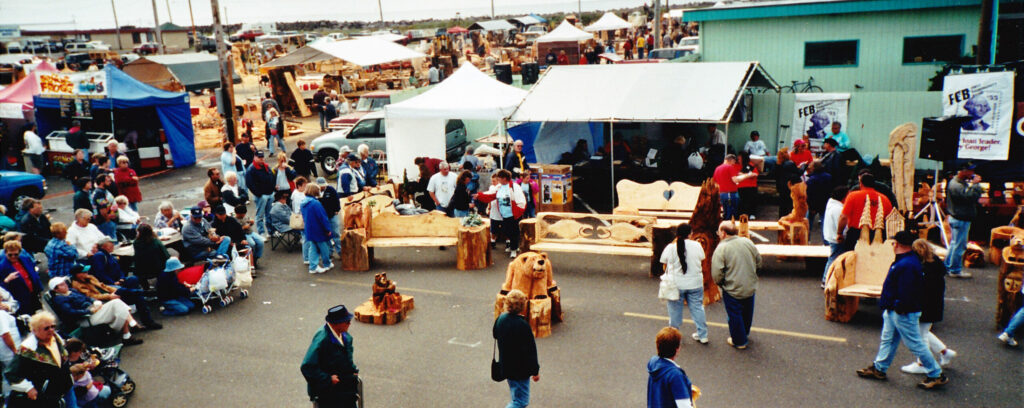
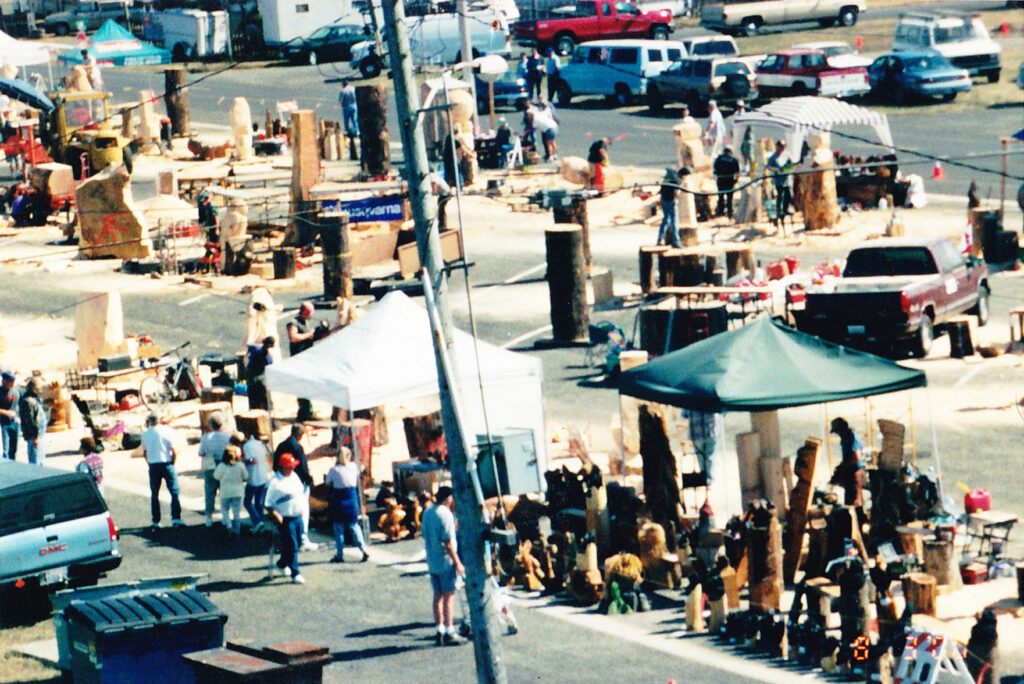
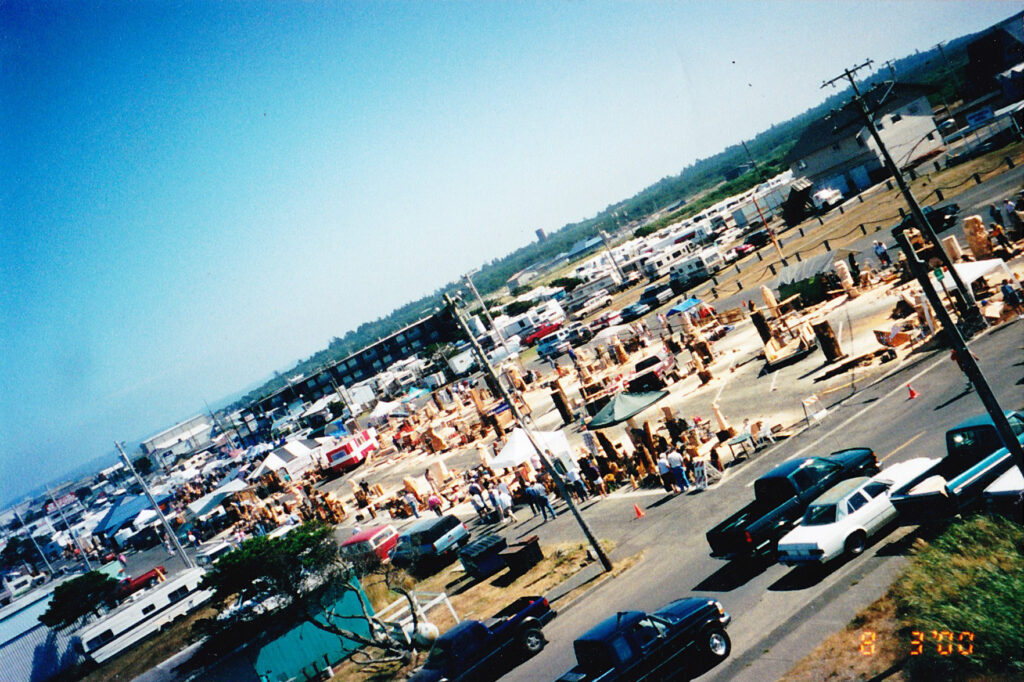
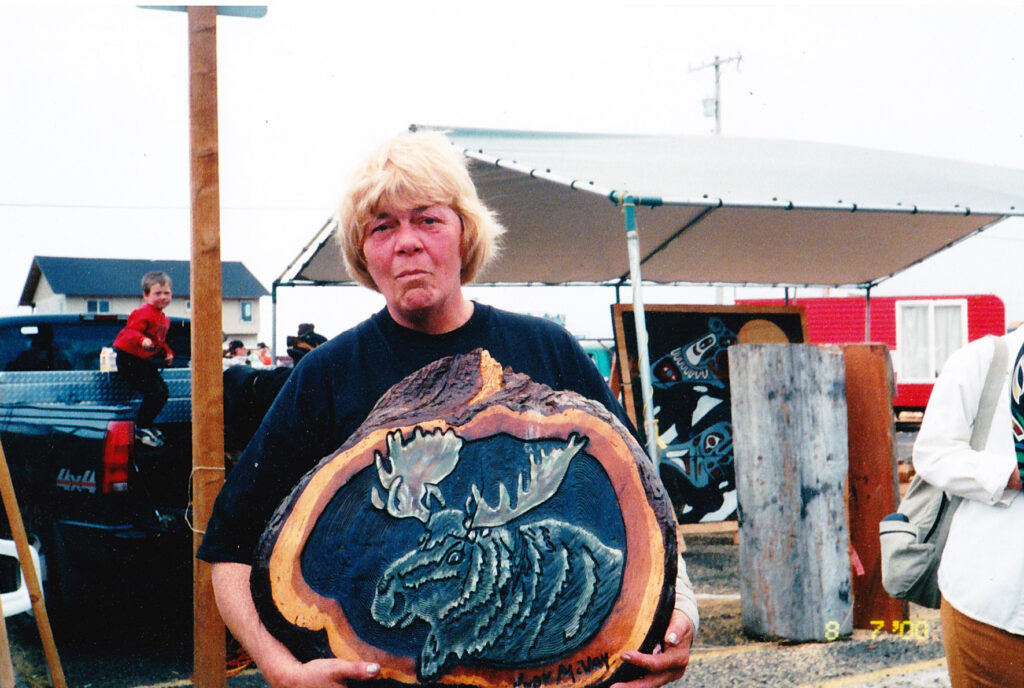
<2005 – 2020> MAKING HISTORY IS A GROUP EFFORT
Billed at the time as the largest chainsaw carving event in the world, Westport directly and indirectly spawned other events worldwide. International carvers came and took home information, inspired to start their own competitions while Reedsport, Sedro Woolley, Chetwynd, Ocean Shores Sand and Sawdust, and several more events were directly spawned from Westport. Other events, such as those at Ocean City Marketplace which Boaz started when he owned that venue (1995 – 2007), the Deming Carving Event promoted by Lynn for years, plus others can all be tied back to Westport as the catalyst.
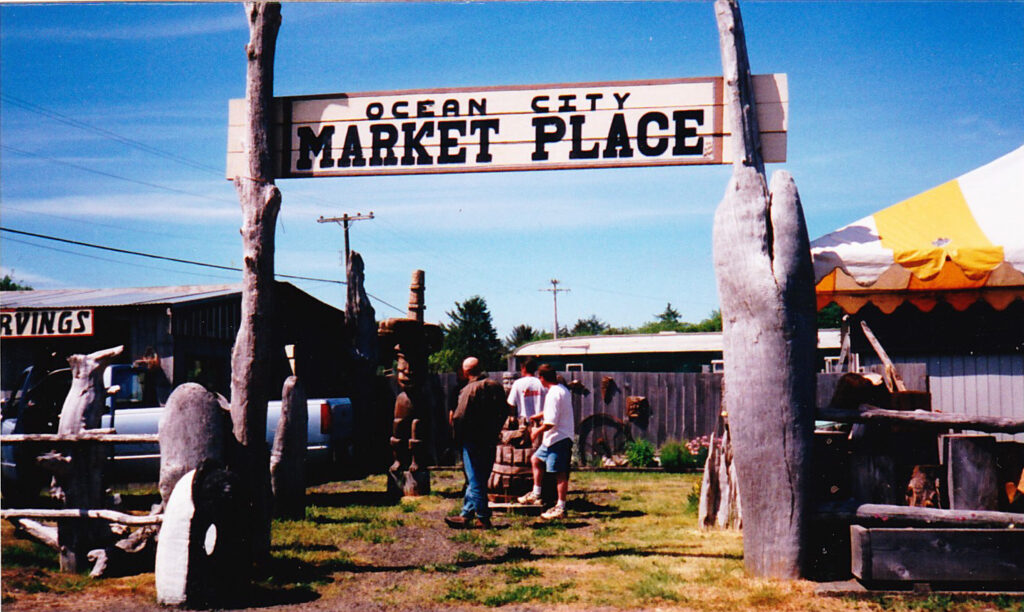
(Epilogue)
Today, Mike and Judy are kinda-sorta retired; Mike on Whidbey Island and Judy in Eastern Washington along with her sister Eileen. Pat also lives and works on Whidbey Island where he is carving, crafting fine furniture, and restoring woodcarvings; Steve and Nanette have their home and shop there too. Lynn and Boaz are in Eastern Washington, still carving. Steve, is a die-hard chainsaw woodcarver, sharpening his own saws with one hand and consulting on events with the other 😉 and Boaz is very much traveling the world over auctioneering and exhibiting their work.
Carve or starve a family tradition since 1956!
Please Note: the history will be updated as time and details change, and we’d love to hear any additions that might need to be made and carver stories that can be added. If you know of anything we missed or you or someone you know is a part of this history and wants to contribute, please contact us to setup an interview with our biographer.
